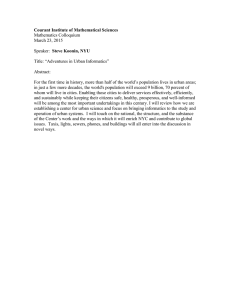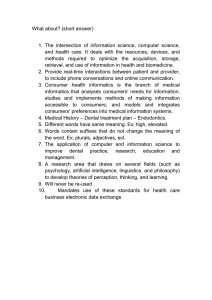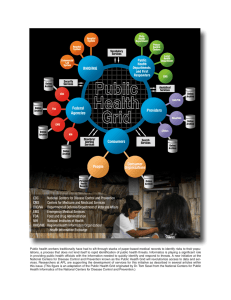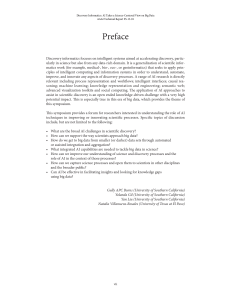CPI 101: Introduction to Informatics Fall 2007 Dianne Hansford
advertisement
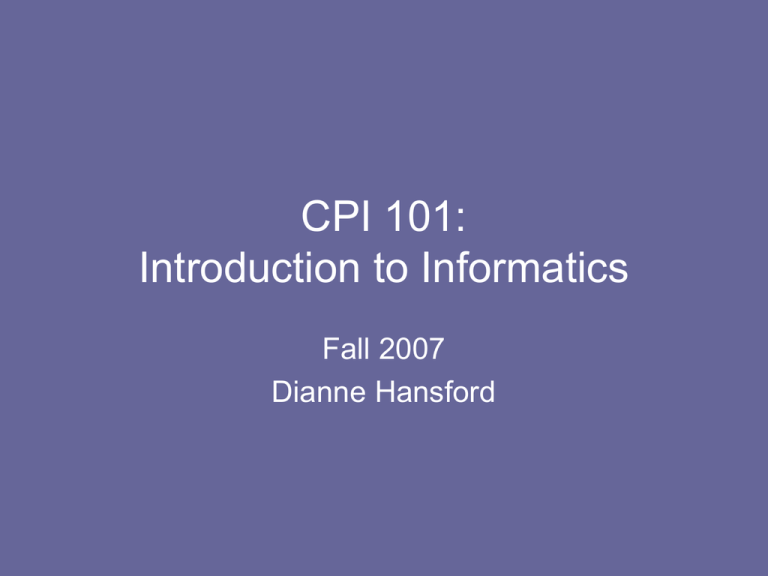
CPI 101:
Introduction to Informatics
Fall 2007
Dianne Hansford
What is Informatics?
• Study of how information is collected, stored,
manipulated, classified, organized, retrieved,
visualized, ....
• How does it differ from
> Information Technology?
> Information Science?
> Computer Science?
Origins of ‘Informatics’
• 1962 France: Phillipe Dreyfus, a French information
system/software pioneer
Combination of “information” and “automatic”
“tic” in Greek = “theory”
• 1962 US: Walter Bauer founded a company named
Informatics.
• Today Europe: “Informatics” = Computer Science
• Today US: widely used in application contexts:
medical informatics, chemical informatics, bioinformatics
Importance
• Every day we are touched/influenced by
informatics
– Email, Google, YouTube, Blogs, FaceBook,
Travelocity, GPS systems, iTunes, Univ. Resgistrar,
.........!
• data-centric world
– new data acquisition devices
– everyone is creating content
• data information knowledge
– key to advances in science, engineering, medicine, ...
‘Tools for ...’ Approach
• People & systems view of informatics
• Tools for
–
–
–
–
–
memory,
routine activity,
modeling, inference, and visualization,
decision making and problem solving
communication, networking, and interaction
• Still a combination of how information is collected,
stored, manipulated, classified, organized, retrieved,
visualized
No escape now!
• Data keeps coming
– data acquisition tools
– everyone publishes
• People with needs and
hunger for tools
• Systems encapsulate
functionality
• Result: Tools for....
Informatics!
Central Goal of Informatics:
Data Information Knowledge
• Data acquisition explosion
– {Remote} sensing/scanning technologies, motes, ....
– Automated data collection
• Biology: Experiments can collect 1 Gigabyte (GB) / day (10^9 bytes)
• Astronomy: 1 Terabyte / day (10^12 bytes)
• Information
– Automated “curation” of data
– Store, organize, manipulate, retrieve
• Knowledge
– Automation of hypothesis formation & experimentation: “machine
learning”
– Working on this!
• Informatics delivers this process as a system
Flood of Information
• Study estimated that all phone
calls in 2002 contained about
17 exabytes (EB) of new
information
– 1 exabyte = 1 billion GB
– good luck FBI!
• All conversation ever had by
human beings (saved as text)
= 5 EB (maybe)
• Huge gap in data aquisition
and informationknowledge
capacity
Example: Bioinformatics
• Unprecedented access to biological data
– data acquisition
• Managing biological databanks with numerous
contributors and users
– store, organize, networks
• Extracting useful information from large and dense
biological data
– manipulate, visualize
• Assembling molecular pieces into predictive models of
biological systems for in silico experiments
– modeling, inference
– scientific computing: multiprocessor, faster processors
Informatics as the Bridge
• Connects people through IT to discipline
(domain) areas
• Focus on applications: use of highly
sophisticated applications and development of
new applications, designed so people can use
them
• Brings us back to the ‘Tools for ...’ structure of
course!
Building the Bridge
Human-Computer Interaction (HCI)
• HCI design is key to building this bridge
• (Cognitive) psychology an important field of work
for creating tools that make us
– efficient
– creative
– able to envision better computational tools
• But ... fundamental computer science research
is important too
• `It takes all types!’
Humans
Computers
(Need for a Bridge)
•
•
•
•
•
•
•
•
•
slow
prone to error
irrational
emotional
inferential
random
unpredictable
ethical
intelligent
•
•
•
•
•
•
•
•
•
fast!
error-free (sort of)
deterministic
apathetic
literal
sequential (mostly)
predictable
amoral
stupid (mostly)
Caveat: This is a bit of a hyperbole to make the point.
Informatics Certificate
• CPI 101: Overview of courses to com
– Experience with ‘Tools for’
– Breadth rather than depth
• CPI 200: “Computational Thinking”
• Next level
– CPI 410 Tools for storing, organizing, retrieving
– CPI 460 Tools for problem solving, decision-making
• Elective – choose one
– From given list or from your degree program
• Website: http://sci.asu.edu/undergraduate/informatics_cert.php
References
• Wikipedia
• Mike Dunn, School of Informatics, Indiana Univ.
http://www.informatics-schools.org/ppt.php?page=1
• ‘Champing at the Bits’, Nature March 2006
